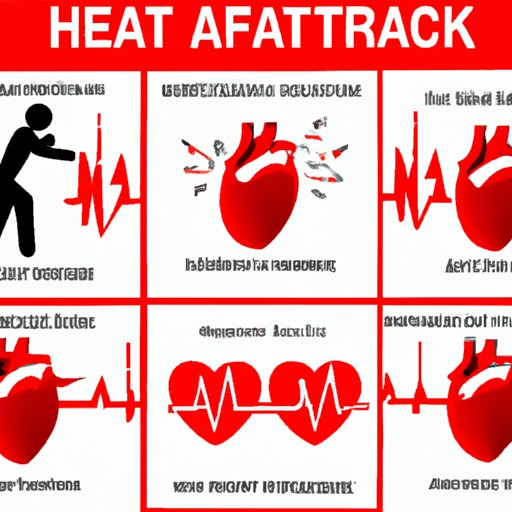
I. Introduction
A heart attack is a life-threatening medical emergency that occurs when there is a blockage in blood flow to the heart. According to the Centers for Disease Control and Prevention (CDC), heart disease is the leading cause of death in the United States, with heart attacks accounting for a significant number of those deaths. While genetics may play a role in an individual’s risk for a heart attack, there are a number of lifestyle factors that can also contribute.
While the prospect of experiencing a heart attack can be daunting, it is important to educate oneself on how to recognize the warning signs and steps that can be taken to prevent them, or mitigate their impact.
II. Recognizing the warning signs
The warning signs of a heart attack can vary from person to person, and not everyone will experience the same symptoms. However, some common warning signs include:
- Chest pain or discomfort
- Shortness of breath
- Nausea or vomiting
- Lightheadedness or dizziness
- Pain or discomfort in the arms, shoulders, back, neck, or jaw
It is important to act quickly if you or someone around you experiences any of these symptoms, as prompt medical attention can make all the difference in the outcome of a heart attack.
III. Prevention measures
While there are some risk factors that may be out of an individual’s control, such as age or family history, there are steps that can be taken to reduce the risk of a heart attack. Lifestyle changes are key in this regard, as regular exercise, a diet high in fruits and vegetables, and quitting smoking can all make a significant difference. Additionally, managing conditions such as high blood pressure or high cholesterol can also help mitigate risk.
Other preventative measures include:
- Maintaining a healthy weight
- Limiting alcohol consumption
- Reducing stress
- Avoiding excessive caffeine consumption
IV. Seeking immediate help
If you suspect someone is having a heart attack, it is important to call 911 or seek emergency medical attention right away. Prompt medical care can help mitigate damage to the heart muscle and improve outcomes. When calling emergency services, be sure to provide information about the symptoms being experienced and the individual’s location. Remain on the line until you have provided all necessary information and follow any instructions given to you by the operator.
V. The role of medication
There are a number of medications that can be used to treat a heart attack, but it is important to seek medical advice before taking any medication. Some medications that may be used include:
- Aspirin: commonly used to lower the risk of blood clots
- Nitroglycerin: helps to widen blood vessels and improve blood flow
- Blood-thinning medications: such as heparin or warfarin
It is important to follow dosage instructions closely and only take medication under the guidance of a medical professional.
VI. CPR training
Learning cardiopulmonary resuscitation (CPR) can be a life-saving skill in the event of a heart attack. CPR involves compressing the chest to help maintain blood flow to vital organs until medical attention can be obtained. The basic steps of CPR include:
- Check the person’s airway, breathing, and pulse
- If the person is not breathing, begin chest compressions
- Continue chest compressions and rescue breathing until medical attention arrives
In-person CPR training is available through organizations such as the American Red Cross and the American Heart Association. Online courses are also available, but it is important to ensure that any course taken meets certification requirements in the event that you need to perform CPR in an emergency situation.
VII. Knowing the risk factors
There are several factors that can increase an individual’s risk of experiencing a heart attack, including:
- Increasing age
- Family history of heart disease
- High blood pressure
- High cholesterol
- Diabetes or insulin resistance
- Smoking
While some of these factors may be out of an individual’s control, it is important to take steps to manage them through lifestyle changes or medication as appropriate.
VIII. Conclusion
Heart attacks are a serious medical emergency but recognizing the warning signs, taking preventative measures, seeking immediate medical attention, and knowing CPR can all help increase the likelihood of a positive outcome. While some risk factors may be out of an individual’s control, there are steps that can be taken to mitigate risk and improve heart health. By taking these steps, individuals can help protect themselves from the risk of a heart attack.




